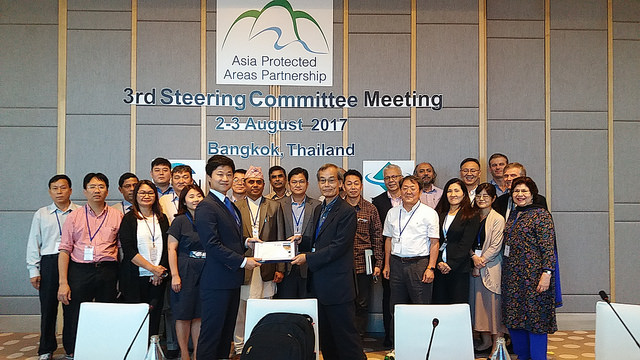Asia Protected Areas Partnership Poised to Enter New Phase
Regional collaboration on protected areas in Asia continued to gather momentum on a number of fronts, with the announcement of several new developments at the 3rd Steering Committee meeting for the Asia Protected Areas Partnership (APAP) in Bangkok, Thailand, on 2 and 3 August 2017.

Photo: IUCN Asia
On the governance front, the Ministry of Environment of the Republic of Korea is to become the new co-chair for the Partnership in November 2017, taking over from the Ministry of Environment of Japan, which has held the position for the last three years. MoE-Korea - APAP's newest member - will work closely with the Korea National Parks Service (KNPS) to offer technical and financial support to APAP. As a first step in this direction, KNPS has seconded Ms Minsun Kim, Programme Officer with the Partnership Department, to the IUCN Asia Regional Office in Bangkok.
"Even though protected areas across Asia have different fauna and flora and are managed differently, we have a common goal of conserving our nature for a better future. We will do our best to work with the Ministry of Environment and see that Asia takes the lead in biodiversity conservation through APAP," said Mr Jong-hee Kim, Director of the KNPS Partnership Department.
APAP member countries also reported on their progress towards Aichi Target 11, which calls for at least 17 per cent of terrestrial and inland water areas and 10 per cent of coastal and marine areas, to be conserved and integrated into the wider landscape and seascape by 2020. Member countries also reported on new protected area-related developments and activities since the last Steering Committee meeting.
While virtually every country in the region has ambitious plans to expand its protected area system, many common challenges were identified. These included the need to arrest habitat loss and degradation, build capacity, mobilize resources, engage communities, address the growing problem of human-wildlife conflict, and manage invasive alien species. Climate change was identified as an over-arching concern.
The presentations made at the meeting revealed that countries have adopted a wide array of diverse and innovative strategies to tackle these concerns. In Pakistan, for example, efforts are being made to enhance the biodiversity value of canals and roadside plantations, so that they can serve as ecological corridors. In Bhutan, crop insurance schemes have proven to be a successful mechanism for mitigating crop damage by wildlife. In Cambodia, land areas that were previously in economic land concessions have reverted to protected areas and local community ownership. In Vietnam, considerable emphasis has been placed on aligning the different environmental laws, ensuring that biodiversity is mainstreamed into different sectors, and strengthening biodiversity impact assessment.
Discussions also took place about APAP's future direction, including the potential for collaboration with IUCN’s Global Protected Areas Programme (GPAP) and the World Commission on Protected Areas (WCPA). In this connection, Trevor Sandwith, GPAP Director, gave a well-received presentation on IUCN’s global protected area priorities for the next four years. Plans for the 3rd APAP technical workshop were also discussed; this will focus on human-wildlife conflict, and will be held in Bhutan in November 2017.
“In terms of priorities, we want to build on the momentum that has now been established and move from a focus on partnership building to developing joint activities,” said Dr Scott Perkin, Head of Natural Resources Group for IUCN Asia. “We will place an emphasis on increasing the number of capacity building and experience sharing events, actively explore the potential for transboundary initiatives and joint projects, and continue to expand the membership and raise the profile of APAP at regional and global events.”
Ms Aban Marker Kabraji, Regional Director for IUCN Asia and Co-Chair of APAP, concluded the meeting by saying, “The success of a programme can often be measured by its sustainability. It is indeed a good indicator that APAP is being recognized for its importance when governments like Korea offer to take over the chair and provide financial and technical support to the secretariat. Together with Japan, Korea is setting an example for other countries to take ownership of the governance of the Partnership, to ensure its long-term viability.”
Asia Protected Areas Partnership (APAP) has been designed as a key platform to help governments and other stakeholders collaborate for more effective management of protected areas in the region. The partnership was initiated in 2013 at the first-ever Asia Parks Congress held in Japan, and formally launched the following year at the IUCN World Parks Congress in Australia. It is chaired by IUCN, International Union for Conservation of Nature, and co-chaired by an APAP member organisation on a rotational basis, beginning with the Ministry of the Environment, Japan.



